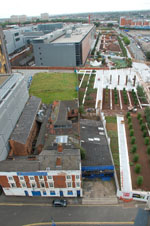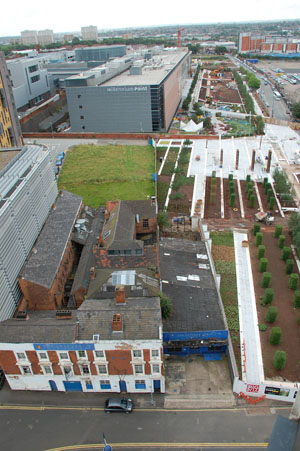Lights coming back on at Christopher Wray
 One of Birmingham’s most interesting disused historic buildings is set to be restored following a deal between its owner and local developer Linford C-Zero.
One of Birmingham’s most interesting disused historic buildings is set to be restored following a deal between its owner and local developer Linford C-Zero.
The former Christopher Wray Lighting Factory on Bartholomew Row is something of a local cause célèbre. The site, which was once valued at over £2m for residential development, has had a dogged planning history culminating in an application for demolition last year.
An argument was put forward that the buildings were beyond economic repair, blighted by a Compulsory Purchase Order which was never carried out, and a Grade II listing of the whole site. The application was turned down leaving the owner at his wits end.
In came Linford C-Zero, founded by former Linford-Bridgeman Director Simon Linford. Linford is putting together his love of historic buildings with sustainable development expertise to take on development projects others might be frightened of. Flush from success in restoring Little Bolton Town Hall, he was looking for a project in his home town and the Christopher Wray building seemed ideal. Since it ceased to be used by the eponymous lighting manufacturer in 2003, this Grade II listed building has gradually fallen into disrepair, and now sits as a rather sorry sight alongside Birmingham’s busy inner ring road. 9-12 Bartholomew Row, to give the correct address, is not just one building but a collection of structures, the significance of which lies not in their beauty or architecture, but in their history. In many ways their development over time has been a microcosm of the development of Birmingham, adapting for changing use as the City has changed around them. They started off as a terrace of houses in Bartholomew Row in the mid/late 18th century, overlooking the newly built St Bartholomew’s Chapel in a new suburb of the growing city. By the end of the century, they were partly being used as maltings and by the early 19th century shops and a warehouse had been constructed.
9-12 Bartholomew Row, to give the correct address, is not just one building but a collection of structures, the significance of which lies not in their beauty or architecture, but in their history. In many ways their development over time has been a microcosm of the development of Birmingham, adapting for changing use as the City has changed around them. They started off as a terrace of houses in Bartholomew Row in the mid/late 18th century, overlooking the newly built St Bartholomew’s Chapel in a new suburb of the growing city. By the end of the century, they were partly being used as maltings and by the early 19th century shops and a warehouse had been constructed.
The mid 19th century saw the loss of two of the houses, which were re-built by the 1860s, and by the early 20th century the buildings which survive at 9 to 12 and to the rear were all built. 7 and 8, the church and the buildings north of No 12 were lost during or soon after the war and, as a consequence, the surviving buildings at 7 and 8 were re-built when Christopher Wray took over the buildings.
The buildings are an unusual surviving example of how domestic 18th century buildings have been adapted and extended to meet the needs and aspirations of their times. Their last use was as a factory and showroom for Christopher Wray lighting, but the business left nearly 10 years ago.
Significantly 9-12 Bartholomew Row is right next to Birmingham’s flagship new “Eastside City Park”, and this provides the key to its future. It is one of few heritage buildings which feature in the “Eastside Masterplan”, along with Grade I listed Curzon Street station. Linford C-Zero is looking at a mix of uses for the site, including student accommodation (Birmingham City University is relocating to the area), small offices and retail. It is proposed that central to the scheme will be a new brewpub, whilst a wine bar or club could exploit the extensive cellars. New buildings on sections of the site not deemed to be significant will not only enable the conservation deficit to be overcome, but will also enable the features of the most important parts of the complex to be seen and understood.
Linford C-Zero is focused on sustainable development. The adaptation and reuse of historic buildings is an inherently sustainable activity. The energy embedded in them is an investment. Informed, careful adaptation can not only reduce the amount of energy expended in creating new development, but also achieve greater energy efficiency, sustaining the utility of historic places into the future. C‑Zero will use the development to demonstrate techniques for improving the energy efficiency of historic buildings, while new buildings on the site will be to the highest environmental standards, in line with the rest of Eastside’s aspirations.
The development is a challenging one, which Linford relishes. Director Simon Linford describes the opportunity: “The history of this site is one of change, of adding and subtracting buildings as their use has developed, and as the surrounding environment has changed. For the buildings to survive into the future this process needs to continue. The key to constructive conservation is re-use – these buildings have evolved over 250 years, and will now evolve once again.”
Linford has established a Facebook site to keep interested people informed of the development, and give the opportunity for Birmingham people in particular to comment and make suggestions. The Facebook site already has pictures of the buildings, and fascinating maps showing how the buildings and neighbourhood evolved over the last 250 years. It can be found at http://www.facebook.com/ChristopherWrayBuilding.
• For more information about Linford C-Zero visit http://czero.com/.













